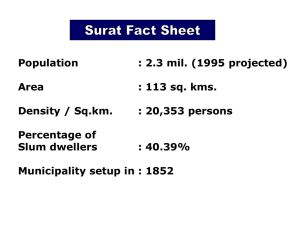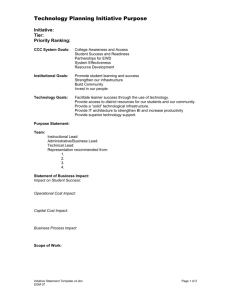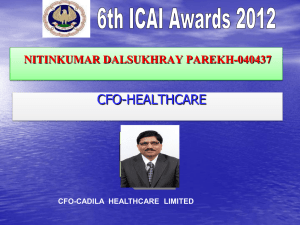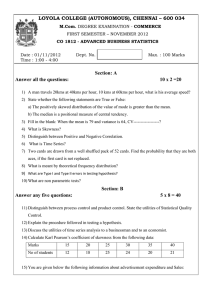10 ELEVENTH FIVE YEAR PLAN - A REVIEW Chapter
advertisement
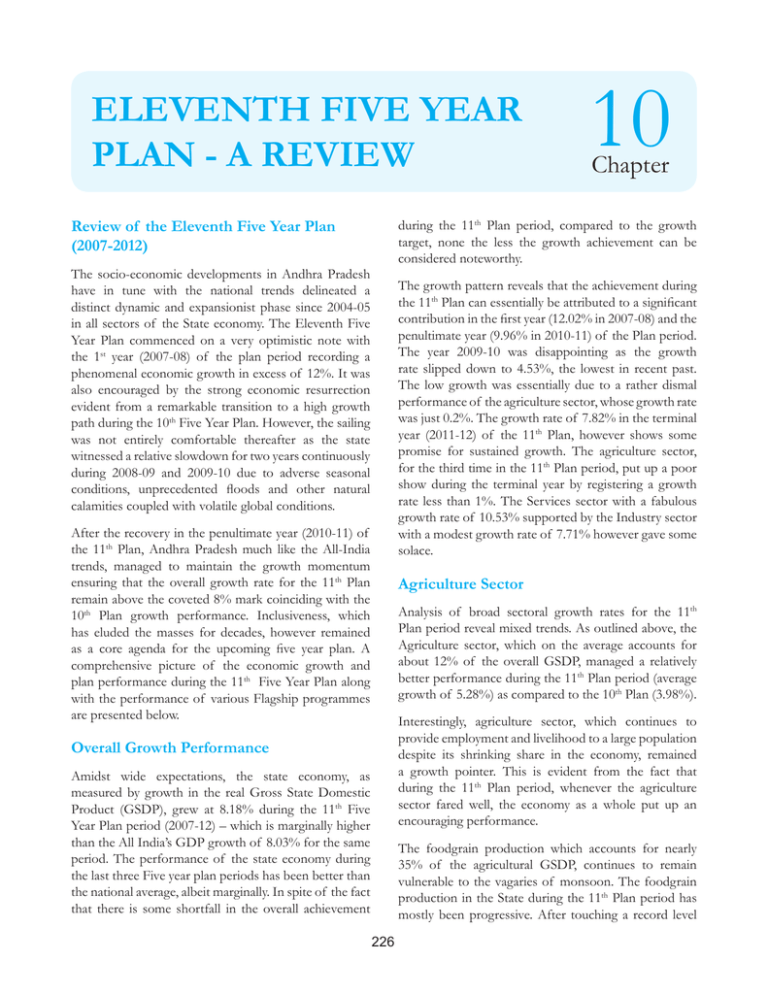
ELEVENTH FIVE YEAR PLAN - A REVIEW Review of the Eleventh Five Year Plan (2007-2012) 10 Chapter during the 11th Plan period, compared to the growth target, none the less the growth achievement can be considered noteworthy. The socio-economic developments in Andhra Pradesh have in tune with the national trends delineated a distinct dynamic and expansionist phase since 2004-05 in all sectors of the State economy. The Eleventh Five Year Plan commenced on a very optimistic note with the 1st year (2007-08) of the plan period recording a phenomenal economic growth in excess of 12%. It was also encouraged by the strong economic resurrection evident from a remarkable transition to a high growth path during the 10th Five Year Plan. However, the sailing was not entirely comfortable thereafter as the state witnessed a relative slowdown for two years continuously during 2008-09 and 2009-10 due to adverse seasonal conditions, unprecedented floods and other natural calamities coupled with volatile global conditions. The growth pattern reveals that the achievement during the 11th Plan can essentially be attributed to a significant contribution in the first year (12.02% in 2007-08) and the penultimate year (9.96% in 2010-11) of the Plan period. The year 2009-10 was disappointing as the growth rate slipped down to 4.53%, the lowest in recent past. The low growth was essentially due to a rather dismal performance of the agriculture sector, whose growth rate was just 0.2%. The growth rate of 7.82% in the terminal year (2011-12) of the 11th Plan, however shows some promise for sustained growth. The agriculture sector, for the third time in the 11th Plan period, put up a poor show during the terminal year by registering a growth rate less than 1%. The Services sector with a fabulous growth rate of 10.53% supported by the Industry sector with a modest growth rate of 7.71% however gave some solace. After the recovery in the penultimate year (2010-11) of the 11th Plan, Andhra Pradesh much like the All-India trends, managed to maintain the growth momentum ensuring that the overall growth rate for the 11th Plan remain above the coveted 8% mark coinciding with the 10th Plan growth performance. Inclusiveness, which has eluded the masses for decades, however remained as a core agenda for the upcoming five year plan. A comprehensive picture of the economic growth and plan performance during the 11th Five Year Plan along with the performance of various Flagship programmes are presented below. Agriculture Sector Analysis of broad sectoral growth rates for the 11th Plan period reveal mixed trends. As outlined above, the Agriculture sector, which on the average accounts for about 12% of the overall GSDP, managed a relatively better performance during the 11th Plan period (average growth of 5.28%) as compared to the 10th Plan (3.98%). Interestingly, agriculture sector, which continues to provide employment and livelihood to a large population despite its shrinking share in the economy, remained a growth pointer. This is evident from the fact that during the 11th Plan period, whenever the agriculture sector fared well, the economy as a whole put up an encouraging performance. Overall Growth Performance Amidst wide expectations, the state economy, as measured by growth in the real Gross State Domestic Product (GSDP), grew at 8.18% during the 11th Five Year Plan period (2007-12) – which is marginally higher than the All India’s GDP growth of 8.03% for the same period. The performance of the state economy during the last three Five year plan periods has been better than the national average, albeit marginally. In spite of the fact that there is some shortfall in the overall achievement The foodgrain production which accounts for nearly 35% of the agricultural GSDP, continues to remain vulnerable to the vagaries of monsoon. The foodgrain production in the State during the 11th Plan period has mostly been progressive. After touching a record level 226 of 204 lakh tonnes in 2008-09, the foodgrain production slipped to 156 lakh tonnes during 2009-10 due to adverse seasonal conditions and bounced back thereafter to 203 lakh tonnes in 2010-11. However, the foodgrains production has come down to 184 lakh tonnes during 2011-12 due to deficient rainfall and consequent drought conditions that prevailed across the state. physical infrastructure are required to grow faster to boost the industrial growth momentum. Within the Industry sector, Electricity, Gas and Water Supply sub sector grew with an impressive growth rate of 10.07% and Construction subsector with a growth rate of 8.24% maintained a steady and sustained growth. Mining & Quarrying subsector, showing a volatile trend, grew at 3.12%. However, after witnessing a slump during 2008-09, this subsector has recovered considerably in subsequent years of the 11th Plan period. The impact of slowdown coupled with adverse seasonal conditions in the State is evident in almost all sub-sectors within Agriculture sector. The Livestock sub-sector of late has emerged as an important alternate source of income to a large number of small and marginal farmers, particularly in drought prone areas. The State accounts for more than 10% of the country’s livestock and ranks 1st in Egg and Meat production and 2nd in milk production. The Government has formulated a State Milk Mission envisaging a huge outlay benefiting 25 lakh persons spreading over a period of next five years to enhance production in the State. The Livestock sub-sector which on average contributes more than 26% of the Agri-GSDP and 5.4% of the overall GSDP grew at 7.1% during the 11th Plan period. The manufacturing sub-sector (registered& unregistered), which on average accounts for more than 48% of the Industrial GSDP and over 12% of the GSDP, grew at 7.63% during the 11th Plan period. The Registered and un-registered components of the manufacturing sector accounted for about 36% and 12% of the Industrial GSDP respectively. The manufacturing sector has to grow at a higher pace if the Industry sector is to propel overall growth momentum and employment. Services Sector Services sector continues to garner a lion’s share (over 53%) in the GSDP and the consistently high growth rates in this sector has resulted in a growth of 9.81% during the 11th Plan period. Sub-sectors of Communications, Banking & Insurance, Real estate & Business services and Transport (other than Railways) & Storage have shown encouraging trends under the Services sector. Fisheries is yet another promising sub sector in the State. The State ranks second in the country in fish production. The Fisheries sub-sector which on average contributes 12.1% of the Agri-GSDP and 2.6% of the overall GSDP grew at over 10% during the 11th Plan period. Forestry in the State has been consistently growing around 2% during the 11th Plan period. Several Forestry programmes to protect and develop existing forest area and bring back tree cover to desired levels are being implemented. More than 5 lakh hectares of degraded forest is being protected, developed and managed by Vana Samrakshna Samithis in the State. The Forestry & Logging sub-sector which on average contributes 5.57% of the Agri-GSDP and 1.2% of the overall GSDP has grown at 1.9% during the 11th Plan period. Per Capita Income Noteworthy increases in Per Capita Income in the recent past broadly indicate improvement in livelihoods of people. The Per Capita Income of the state at current prices has more than doubled in a span of five yearsfrom Rs. 33,135 during 2006-07 to Rs. 68,970 in 201112, the terminal year of the 11th Plan period. In fact, the growth in Per Capita Income of the State is more rapid compared to All-India figures and the state has maintained the dominance for the entire 11th Plan period. Overall during the 11th Plan period, the Agriculture sector on average contributed 21.27% of the GSDP and grew at 5.28%. Effective implementation of several poverty-alleviating and employment generating programmes of the State and those sponsored by the Centre, aided by a better delivery mechanism and safety nets in place, have helped people maintain relatively better standards. Industry Sector During the 11th Plan period, the Industry sector on average contributed over 25% of the GSDP and grew at 7.26%, which however was lower than the 10th Plan achievement. Power shortage has led to much of the slowdown in the industry sector. Power and other Annual Plans – A Recap of Performance Against the total outlay (the sum of the outlays 227 approved by the Planning Commission for the annual plans of the Eleventh Plan Period - 2007-08 to 2011-12) of Rs.1,87,796.75 crore, an amount of Rs.1,58,020.86 crore has been spent accounting for 84.14% of the total outlay. incurred exceeding the outlay of Rs.7958.37 crore. Appropriate planning, scientific approach and efficient management systems have been put in place under Rural Development to increase productivity of degraded lands and create employment opportunities for the poor. Development of degraded lands was regarded as an important input required for eradication of poverty.. Watersheds Development Programme, Comprehensive Land Development Programme and Wage Employment Programmes (MGNREGS-AP) are being implemented in the State are some such intiatives. To this effect, greater emphasis was accorded in the Eleventh Five Year Plan period to these activities. Under Rural Development, Rs.16330.24 crores was spent (106.94% to its outlay and 10.33% of the total expenditure) against an outlay of Rs.15269.84 Crores (8.13% of total outlay). During the 11th Plan period (2007-08 to 2011-12), Economic Services accounted for larger part of the total outlay (about 64%), followed by Social Services (over 35%) and General Services less than 1%. Almost similar shares of expenditure have been recorded by each of these broad sectors (as a percentage to total expenditure). Irrigation sector with an outlay share of 39.8%, Housing with 8.9% share and Rural Development with 8.1% are the major stakeholders in the total outlay. Other prominent sectors include: Urban Development, Welfare and Transport sectors. Transport Sector, with an outlay of Rs.10332.23 Crores accounted for a share of 5.50% in the total outlay during the Eleventh Five Year Plan, and the expenditure was Rs.9983.65 Crores(6.32% of the total expenditure). A perusal of the broad sectoral classification reveals that, an outlay of Rs.120068.51 Crores (63.94% of the total outlay) was provided against which Rs.100029.56 Crores (83.31% to sectoral outlay) has been spent under Economic Services in the Eleventh Five Year Plan. The outlay for Social services was Rs.66659.13 Crores (35.50% of the total outlay) and expenditure Rs. 57229.93 crores (85.85% of sectoral outlay) and under General services an amount of Rs.1069.11 crores was provided as outlay, which is less than 1% of the total outlay, and an expenditure of Rs.761.37 crores was incurred. Under General Economic Services, the expenditure for Eleventh Five Year Plan period was Rs.4361.78 Crores, which amounts to 75.13% of its outlay of Rs. 5805.85 Crores. The state has committed itself to focus on increasing public spending on social sector, especially on Housing, Urban development and welfare of SCs, STs, minorities etc besides setting up targets under priority sectors like irrigation, agriculture and rural development and aiming to ensure faster social development through inclusive pattern of growth. Sizable investments have been made under economic services, in the irrigation and flood control sector to achieve targeted agricultural growth by creating more irrigation potential. To this effect, the Government during the year 2004 has taken up plans for fully utilizing available yields of Godavari and other rivers and initiated the ‘Jalayagnam’ with an aim to complete ongoing and other new projects to provide immediate irrigation to water-starving segments on top priority. In tune with this broad strategy, the State Government allocated an outlay of about 40% i.e. Rs.74732.52 crores during the Eleventh Five year plan and incurred an expenditure of Rs.54023.86 crores which works out to 72.29% of its total outlay. The Government has emphasised the Housing Sector and allocated an outlay of Rs.16,688.36 crores during the 11th Plan period for providing houses. Rs.11696.54 crores expenditure was incurred which is 70.09% of the housing sector outlay. The Mid-Day Meal Programme is being implemented in the state to children of 1st to 5th class in Government/ Local Bodies/Aided schools to increase nutrition of children. The programme was later further extended up to 8th class to improve retention in schools and to achieve total literacy in the state. The Government continued its focus on school education and initiated several steps including expansion of mid-meal scheme and providing books free of cost to students up to 10th class in Government schools to increase enrolment and reduce drop outs. To this effect, Rs.6308.80 crore Ensuring food security and providing employment to the labour force has been the essential premise of the socioeconomic development policies of the government. Keeping this in view, due priority was accorded to Agriculture and Allied sectors in the Eleventh Five plan period wherein Rs.10401.86 crore expenditure was 228 was spent which works out to 78.92% of the General education sector outlay against an outlay of Rs.7994.19 crore allotted during the Eleventh Plan period under General education. • Accelerated Irrigation Benefit Programme (AIBP), The Government observed that the share of public expenditure on Health compared to private investment in health is low. To correct this imbalance in the Eleventh plan, the Government initiated various programmes to reduce Infant Mortality Rate, Maternal Mortality Ratio, Total Fertility Rate and to increase institutional deliveries and Children Immunization Rate. The Government took up the initiative “Rajiv Aarogya Sree Community Health Insurance” under public private partnership to improve access of BPL families to quality medical treatment of diseases involving hospitalization and surgery. The Government allotted an outlay of Rs.6752.68 Crores for Medical and Public Health and incurred an expenditure of Rs.6288.27 Crores (93.12% to its outlay) to meet this objective in the Eleventh Five year Plan. • National Rural Drinking Watersupply Programme (NRDWP), • Rajiv Gandhi Grameena Vidyutikaran Yojana (RGGVY)/ Re-structured Accelerated Power Development and Reforms Programme (R-APDRP), • Total Sanitation Campaign (TSC)/ Nirmal Bharat Abhiyan(NBA), • Indira Awaas Yojana (IAY), • Jawaharlal Nehru National Urban Renewal Mission (JNNURM), • Pradhan Mantri Gram Sadak Yojana (PMGSY), • Sarva Shiksha Abhiyan (SSA), • Mid Day Meal Scheme (MDM), • National Rural Health Mission (NRHM) • Integrated Child Development Services (ICDS). The detailed outlay and expenditure statements are outlined in Annexure 10.1. • National Social Assistance Programme(NSAP) • National Rural Livelihood Mission (NRLM) Performance of Flagship Programmes • Backward Regions Grant Fund (BRGF) With a view to impart greater momentum to the efforts being made in various sectors, the Government of India has launched flagship programmes under economic infrastructure sector and social sectors. In the recent past, there has been a growing concern for the implementation of flagship programmes. The performance of various flagship programmes during the 11th Five Year Plan period and for the year 2012-13 is briefed hereunder. Financial Performance of Flagship programmes (Rs. Crore) The Chaturvedi Committee on restructuring of the Centrally Sponsored Schemes(CSS) suggested flexibility in the design of the CSS to be given to States to meet their special local needs. The committee suggested that 20% of the budget allocation in all the CSS (10% in Flagship schemes) to be called flexi funds should be earmarked in each scheme for this purpose. Sl. No 1 2 3 4 5 Effective implementation of flagship programmes of the Government of India is going to be cornerstone of development in the coming years, especially during the 12th Five Year Plan. Year Centre 6307.65 8707.00 11053.71 14038.50 9567.30 Releases State 3727.57 5328.02 7099.63 5812.08 8038.00 Total 10035.22 14035.02 18153.34 19850.58 17605.30 2007-08 2008-09 2009-10 2010-11 2011-12 Total (2007-08 49674.16 30005.30 79679.46 to 2011-12) 2012-13 7626.39 4662.97 12289.36 Expenditure 9224.75 11890.86 15788.53 15942.73 17480.82 70327.69 11855.73 Rashtriya Krishi Vikasa Yojana The flagship programmes being implemented by the State are: Government of India (GOI) have launched Rashtriya Krishi Vikasa Yojana (RKVY) as an Additional Central Assistance scheme (100%) in the year 200708 to incentivize states for increasing investments in Agriculture and allied Sectors to achieve a annual growth in excess of 4%. • Rashtriya Krishi Vikas Yojana (RKVY), • National Horticulture Mission (NHM), • Mahatma Gandhi National Rural Employment Guarantee Scheme (MGNREGS), 229 Objectives least 100 days of wage employment to rural households whose adult members are willing to do unskilled manual labour. • To ensure that the local needs/ crops/priorities are better reflected in the agricultural plans of the states. The programme is covered in all the rural areas in 22 Districts in three phases. • To achieve the goal of reducing the yield gaps in important crops through focused interventions. An amount of Rs. 18981.45 crores has been spent during 11th Plan i.e 2007-08 to 2011-12. An amount of Rs.4088.68 crore has been spent for the year 2012-13 (up to December 2012). The Government has enhanced the number of work days per year 150 and the wage rate Rs. 137 per day. • To maximize returns to the farmers. • To bring quantifiable changes in production and productivity of various components by addressing in a holistic manner. During 11th Plan period, an amount of Rs. 1861.74 crore has been spent under the scheme. An amount of Rs. 344.61 crore has been spent for the year 2012-13(up to December 2012) This programme has so far covered 55 Lakh households for the year 2012-13 through issuing 5.35 lakh no. of job cards in 22 districts of Andhra Pradesh. The implementation of the scheme in Andhra Pradesh has been improving over time. Implementation of the programme in the State has received much acclaim by various apex level bodies and monitoring agencies. National Horticulture Mission The State Horticulture Mission(SHM) in Andhra Pradesh was launched on 3rd November, 2005, under National Horticulture Mission with the following main objectives: Accelerated Irrigation Benefit Programme Government of India have initiated assistance under Accelerated Irrigation Benefit Programme (AIBP) to complete the ongoing major and medium irrigation projects taken up with Central Water Commission and Planning Commission Clearances, since 1996–97 to create Irrigation Potential at optimum cost, based on the guidelines issued from time to time. To provide holistic growth of the horticulture sector in cluster approach which include research, technology promotion, extension, post harvest management, processing and marketing. To enhance horticulture production, improve nutritional security and income support to farm households. Projects Sanctioned To establish convergence and synergy among multiple on-going and planned programmes for horticulture development. • 33 projects (7 Major and 16 Medium Irrigation Projects) have been included under A.I.B.P. since 1996-97. To create opportunities for employment generation for skilled and unskilled persons, especially unemployed youth. • 11 Projects (i.e., 5 Major and 6 Medium Irrigation) included prior to 2004 – 2005. The focus crops under SHM are: 1.Mango 2. Sweet Orange 3. Sapota 4. Pomegranate 5.Banana 6.Papaya and 7.Cashew 8. Flowers 9. Spices • 22 Projects (12 Major and 10 Medium Irrigation) included after 2005 -2006. A total amount of Rs. 11785.03 crores has been spent during 11th Five Year Plan under various AIBP projects in the state. An amount of Rs. 664.20 crore has been spent for the year 2012-13(up to December 2012). For carrying out the said activities, an amount of Rs. 607.73 crores during 11th Five Year Plan. An amount of Rs. 88.77 crores has been spent for the year 2012-13 (up to December 2012) has been spent. Rajiv Gandhi Grameena Vidyutikaran Yojana Mahatma Gandhi National Rural Employment Guarantee Scheme The Government of India has introduced Rajiv Gandhi Grameena Vidyutikaran Yojana (RGGVY) programme in the year 2005 with the twin objectives of electrification Mahatma Gandhi National Rural Employment Guarantee Act gives legal guarantee of providing at 230 of villages and to provide access to electricity to BPL households in the country. • Gram Panchayats where all habitations have access to water to be takenup. Priority may be given to Gram Panchayats having functional piped water supply. An amount of Rs. 886.31 crores was incurred under the programme during 11th plan 2007-08 to 2011-12. • Provision of sanitation facilities in Government Schools and Anganwadis in Government buildings within these GPs National Rural Drinking Water Programme National Rural Drinking Water Programme (NRDWP) was launched by GOI in 2009-10 in place of Accelerated Rural Water Supply Programme (ARWSP). The programme intends to provide safe and adequate drinking water facilities to quality affected habitations, not covered habitations and partially covered habitations in rural areas. The program provides special thrust on sustainability of drinking water sources and funds recharge structures with 100% grant. • Solid and Liquid Waste Management (SLWM) for proposed and existing Nirmal Grams An amount of Rs. 4119.31 crores was spent during 11th Plan. An amount of Rs. 371.98 crore has been spent for the year 2012-13(up to December 2012). The main objectives of the NBA are as under: • Extensive capacity building of the stake holders like Panchayati Raj Institutions (PRIs), Village Water and Sanitation Committees (VWSCs) and field functionaries for sustainable sanitation. • Appropriate convergence with MGNREGS unskilled man-days and skilled man-days. a) Bring about an improvement in the general quality of life in the rural areas. Under the National Rural Drinking Water supply Programme, drinking water is provided to 72,387 habitations. 44,720 (61.8%) habitations are fully covered with supply of 40 Litres Per Capita Per Day (LPCD) and more safe drinking water, a norm for fully covered status and 27,276(37.7%) habitations partially covered and 391 are quality affected. b) Accelerate sanitation coverage in rural areas to achieve the vision of Nirmal Bharat by 2022 with all gram Panchayats in the country attaining Nirmal status. c) Motivate communities and Panchayat Raj Institutions promoting sustainable sanitation facilities through awareness creation and health education. Total Sanitation Campaign d) To cover the remaining schools not covered under Sarva Shikha Abhiyan (SSA) and Anganwadi Centres in the rural areas with proper sanitation facilities and undertake proactive promotion of hygiene education and sanitary habits among students. Total Sanitation Campaign (TSC) has been launched by Government of India to ensure sanitation facilities in rural areas with broader goal to eradicate the practice of open defecation by bringing about behavior change. This programme is being implemented with the district as a unit. e) Encourage cost effective and appropriate technologies for ecologically safe and sustainable sanitation. The TSC is now renamed as “Nirmal Bharat Abhiyan” (NBA) with modified guidelines and objectives to accelerate further the sanitation coverage in the rural areas so as to comprehensively cover the rural community with renewed strategies under the programme. The guidelines of NBA and the provisions hereunder are applicable with effect from 01.04.2012. Nirmal Bharat Abhiyan (NBA) envisages covering the entire community for saturated outcomes with a view to create Nirmal Gram Panchayats (NGPs) with following priorities: f) Develop community managed environmental sanitation systems focusing on solid & liquid waste management for overall cleanliness in the rural areas. An amount of Rs. 403.19 crores was spent during 11th Plan and an amount of Rs. 60.36 crores has been spent for the year 2012-13(up to December 2012). Indira Awaas Yojana The scheme intends to provide Houses to BPL families (SC/ST/Minorities/others) living in rural areas. • Provision of Individual Household Latrine (IHHL) of both Below Poverty Line (BPL) and Identified Above Poverty Line (APL) households within a Gram Panchayat (GP) Under the IAY programme, in all, a total amount of 231 Rs. 4996.11 crores has been spent during 11th Five Year Plan. An amount of Rs.983.53 crores has been spent for the year 2012-13(upto December, 2012). The amount includes the state contribution and the Central allocation. Under the IAY scheme, 1,62,968 houses to SC/STs and 39217 houses to Minorities and 68214 houses to others have been sanctioned under IAY programme for the year 2012-13. gaps, with the active participation of the community in the management of schools. The funding pattern for the year 2012-13 is 65:35, between GOI and GOAP. Jawaharlal Nehru National Urban Renewal Mission Mid Day Meal Scheme Under the SSA programme, an amount of Rs. 6922.83 crores was spent during the 11th Five Year Plan(2007-08 to 2011-12) and an amount of Rs. 1675.90 crores has been spent for the year 2012-13(up to December 2012). The objective of the scheme is to improve the nutritional status of children. The scheme also envisages encouraging poor children, belonging to disadvantaged sections to attend school more regularly and to provide nutritional support to children. The Government of India has initiated JnNURM in order to cope with massive problems that have emerged as a result of rapid urban growth, reforms driven, fast track, planned development of identified cities on a mission mode with focus on improve efficiency in urban infrastructure/services delivery mechanism, community participation and accountability of Urban Local Bodies/ Parastatals towards citizens. The main components of the programme are: Urban Infrastructure and Governance (UIG), Basic Services for the Poor (BSUP), Urban Infrastructure and Development Scheme for Small and Medium Towns (UIDSSMT) and Integrated Housing and Slum Development Programme: (IHSDP) Coverage 61,415 Primary Schools including Madarsas/ Maqtabs/ AIE/EGS Centres/NCLP Schools at primary stage, 9,216 Upper Primary Schools and 10,292 High Schools are covered with enrollment of 75.54 lakh children. Under the Mid-Day Meal programme, an amount of Rs. 2320.69 crores, has been spent during 11th Five Year Plan period. an amount of Rs. 448.88 crore has been spent for the year 2012-13(up to December 2012).The amounts include the state contribution and the Central allocation. Under JnNURM, an amount of Rs. 5937.21 crores has been spent during 11th Five Year Plan and an amount of Rs. 505.75 crore has been spent for the year 2012-13 (up to December 2012). National Rural Health Mission Pradhan Mantri Gram Sadak Yojana The Rural Health scheme was launched by the GoI with focus on: Pradhana Mantri Gram Sadak Yojana (PMGSY) was launched with an aim to provide all-weather access to unconnected habitations. It is 100% centrally sponsored scheme. All weather connectivity is to be provided to all the habitations with population of 500 and above (250-500 in case of hilly and tribal areas) under this programme. The programme was commenced in the year 2000-01. • Reduction in Infant Mortality Rate (IMR) and Maternal Mortality Ratio (MMR) • Universal access to public health services such as Women’s health, child health, water, sanitation & hygiene, immunization, and Nutrition. • Prevention and control of communicable and noncommunicable diseases, including locally endemic diseases Under this programme, a total amount of Rs.2562.18 crores has been spent during 11th Five Year Plan. An amount of Rs. 173.13 crores has been spent for the year 2012-13(up to December 2012). • Access to healthcare Sarva Shiksha Abhiyan integrated comprehensive primary • Population stabilization, gender and demographic balance. Sarva Shiksha Abhiyan has been introduced during 2001-02, with an aim to provide useful and relevant elementary education for all children in the 6 to 14 age group. SSA intends to bridge social, regional and gender • Revitalize local health traditions and mainstream AYUSH 232 poor enabling them increase household income through sustainable livelihood enhancements and improved access to financial services and is aided in part through investment support by the World Bank. • Promotion of healthy life styles For implementation of various items subsumed under NRHM, in all an amount of Rs. 3146.89 crores during 11th plan 2007-08 to 2011-12. An amount of Rs. 570.20 crores has been spent for the year 2012-13 (up to December 2012). NRLM constitutes a paradigm shift in the implementation of poverty alleviation programmes in the country. NRLM would provide a combination of financial resource and technical assistance to states such that they could use the comprehensive livelihoods approach encompassing four inter-related tasks viz., Integrated Child Development Services The Integrated Child Development Services (ICDS) is a centrally sponsored scheme and is the single largest integrated programme of Child Development. • mobilizing all rural, poor households into effective self-help groups (SHGs) and their federations; For undertaking various ICDS activities, an amount of Rs. 4133.71 crores has been spent during 11th Five Year Plan and an amount of Rs. 730.84 crore has been spent for the year 2012-13(up to December 2012). • enhancing access of the rural poor to credit and other financial, technical and marketing services; • building capacities and skills of the poor for gainful and sustainable livelihoods; A total of no. 387 ICDS projects have been implemented with 87,880 AWCs in the state. • Improving the delivery of social and economic support services to the poor. An amount of Rs.119.33 crore has been spent for the year 2012-13 (up to December 2012). With regard to physical achievements under supplementary nutrition, in all 55.55 lakh persons have been benefited under the programme during the year 2012-13 so far. Backward Regions Grant Fund The scheme Backward Regions Grant Fund (BRGF) formerly known as Rashtriya Sam Vikas Yojana (RSVY) is being implemented to address the problems of low agricultural productivity, Unemployment, and to fill the critical gaps in physical and social infrastructure so as to redress regional imbalances in development. The Programme is being implemented in 13 districts. Out of these 13 districts, Adilabad, Ananthapur, Warangal, Chittoor, Kadapa, Ranga Reddy, Mahaboobnagar and Vizianagaram are identified under Backward Districts Initiative and Karimnagar, Khammam, Medak, Nalgonda and Nizamabad are identified under Left Wing Extremism. National Social Assistance Programme The NSAP is a flagship programme of the Government of India which aims to provide human security to the poor and the destitute. The programme was launched on 15 August 1995 as a wholly Centrally funded program to give financial assistance to families with little or no regular means of subsistence, living below the poverty line. NSAP presently consists of three components, namely, NOAPS, NFBS, -and Annapurna Scheme. Under this programme, in all, a total amount of Rs. 1663.31 crores has been spent during 11th Five Year Plan and an amount of Rs. 379.28 crores has been spent for the year 2012-13(up to December 2012). The District Collector with the assistance of concerned executive agencies in Panchayat Raj Department is implementing the scheme. Various activities like construction of anganwadi buildings, gram panchayat buildings, health sub-centres, and additional class rooms, roads & drainage, drinking water facilities, sanitation and electricity are being taken up under this programme. An amount of Rs.197.07 crore has been spent for the year 2012-13 (up to December 2012). National Rural Livelihood Mission NRLM was launched by Government of India in June 2011 replacing Swarnjayanti Gram Swarojgar Yojana (SGSY). It is a centrally sponsored scheme funded by the Government of India and the State Government in the ratio of 75:25. The Mission aims at creating efficient and effective institutional platforms of rural 233


